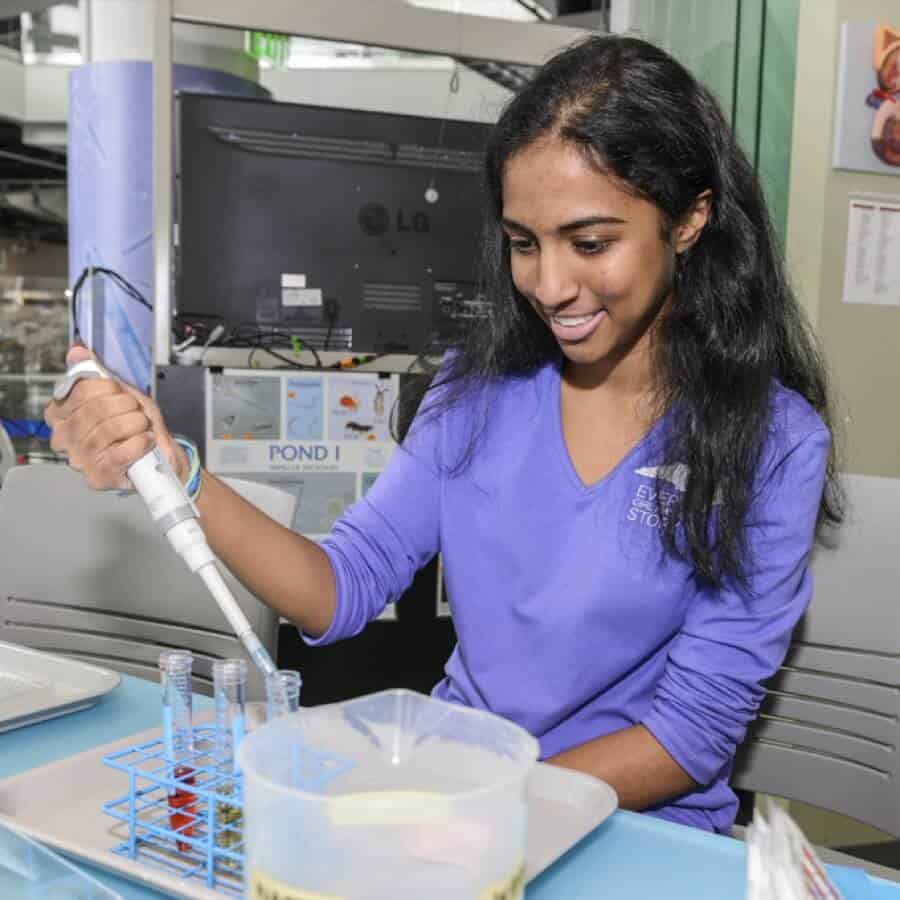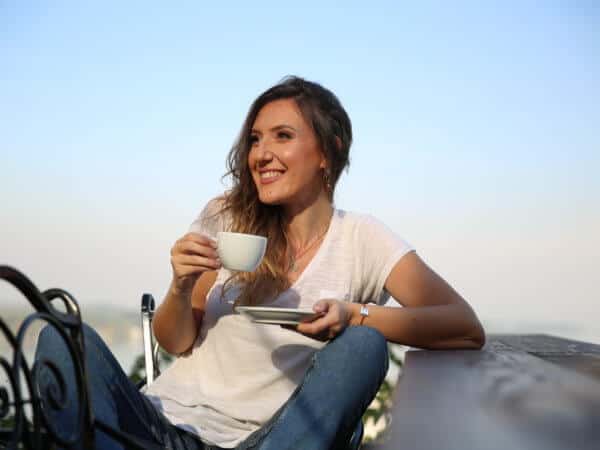It is hard to believe there are still many fatal, not sufficiently explored diseases in the 21st century. One of them, Ebola, took more than 11.000 lives during a three-year-long outbreak in West Africa. In order to increase the public’s awareness of this issue and help students to understand more about how Ebola is diagnosed and treated, Sadhana Anantha, only 19, has designed a simulation of the diagnostic test for this illness. The way she did it and the feedback afterwards brought her the title of 2016 National Young Woman of Distinction by the Girl Scouts of the USA. This is her story.
Meet Sadhana, the Girl Who Found the Diagnostic Test for Ebola in this article. You will also have the opportunity to read her story and to click out inspired.
Dear Sadhana, tell us what you are studying, and are you working on any interesting projects at the moment?
I am currently a freshman biochemistry and health care management/policy major in the seven year BS/MD program at the University of Miami/Miller School of Medicine. I just started working in the Neuroscience lab to focus on axon regeneration, part of the Miami Project to Cure Paralysis.
You are one of only ten girls who were named a 2016 National Young Woman of Distinction by the Girl Scouts of the USA. Can you tell us more about the Ebola Awareness Lab project which won the award for you?
My Girl Scout Gold Award project was focused on the large Ebola outbreak that occurred in West Africa a couple of years ago. I designed a simulation of the ELISA Diagnostic Test, which is used to test for Ebola.
The lab simulation is now an exhibit at the North Carolina Museum of Natural Sciences. Through this gold award project, I wanted to be able to give students a chance to explore certain topics that are not taught in class and see why they matter in the real world.
The connection to a global issue stemmed from the idea that students would see that the solutions to worldwide epidemics are simple but need to be utilized with more efficient methods.
What inspired you the most to take on this project?
The strict structure of classes in school prevents many students from exploring beyond school topics. Common among my peers is concern as to whether their chosen career fields will be true to their passions.
To unleash the creativity in kids as well as help them to become intrigued with the wide range of topics outside the core classes emphasized in school, I chose a simulation to teach students in a fun and visually pleasing way.
The lab is also able to open students’ eyes to clinical science, which is not a field that is commonly taught in school. Compatible with the purpose and environment of the Museum, the lab, I believe, also connects students to issues that matter across the globe.
The one thing I emphasize to the younger kids I mentor as well as to my younger brother is the importance of being well informed.
Keeping up with current events and listening to various opinions strengthens one’s viewpoint. By demonstrating scientific knowledge using the current Ebola outbreak in West Africa, students gain insight into the epidemics going on across the globe.
Can you give us more details about what the project looked like and what was the feedback you got from the children who saw it?
An instruction-information visual was provided on a self-guided iPad while conducting the test. In the simulation, a set of twins was tested for the Ebola virus, the antigen. The concept of testing for unique antibodies was explained through the cascade process initiated by the primary and secondary antibodies.
Phenolphthalein assumed the role of a substrate that identified through a color-change reaction. An innocuous solution of sodium hydroxide or diluted soap was used as the base that caused the color change.
The other solution simply replaced its primary antibody with water instead of a mild base. The twin with the OH concentrated antibody demonstrated a clear to light purple color change and was diagnosed with Zaire Virus.
The concepts of retroactive virus attacks, substrate-enzyme interactions, IgG/IgM antibodies, and Ebola physiology and global health difficulties were explained throughout the self-guided presentation.
The chemical construction of the lab came from the application of titration and neutralization labs conducted in chemistry class at school. Some kids realized how much science interests them and started to pursue the STEM pathway as a career.
A couple of lab participants signed up to be Junior Volunteers in the Museum. I had a kid question why this epidemic was so hard to control. She made the inquiry and visited the lab 2 months later.
She placed 2nd in the North Carolina Science and Engineering Fair with the project An Analysis of a Novel Method of Diagnosing Ebola.
This lab also helped kids to play a more active role in society by educating them about these current events, which they may, in the not so distant future, have to deal with.

The North Carolina Museum of Natural Sciences was your partner in this project. Do you, by any chance, have some new ideas about cooperating with them again?
I have loved volunteering at the Museum since I was ten years old, and I will continue to volunteer and visit it.
However, since I study in a different state, it is hard to commit much time to the museum, but I am definitely looking into projects with my university and local institutions.
What do you think are the best ways of fighting diseases like Ebola or Zika virus in at-risk parts of the world, such as poor African regions?
The World Health Organization has done an amazing job keeping the public updated with the endeavors going on to combat Polio, Malaria, Ebola, Zika, etc. I think the issue with health coverage is the lack of equal access to quality healthcare, a natural right that should be the same across the world.
With public interest, pharmaceutical charity, and standardized care distribution I believe this problem can be solved in due time.
Can you explain what clinical science actually stands for and how it is applied in the real world?
Clinical Science is a field of active medicine in which unique methods of mass manufacturing, business distribution, and science are brought together to help the broad public.
The academically trained concepts we learn in school are applied in the real world in a way that directly helps people live, through medicine. We use our education to make an impact, and for the medical field that is clinical science.
Do you have any role models in science and if so, who?
Dr. Sanjay Gupta has been a long-time role model of mine.
Dr. Gupta is someone whose number one priority is to make the public aware of the health issues going on in out-of-the-way parts of the world.
He does not define a boundary between his job and the humanitarian sense of obligation which drives him to perform his medical duties more by heart than by agenda.
I first began to follow Dr. Gupta when I saw his bravery and comradery during Hurricane Katrina. He risked his life to bridge the gaps separating people, and that’s a quality I truly admire.
What do you think about volunteering as a scientist in poor, endangered parts of the world, would you ever think of embracing a challenge like that?
To work in such an endangered environment is specifically why I chose the premed path. Thirty two kilometers is the distance from my grandparents’ house in Chirala, India to the nearest trauma center.
Thirty minutes is the time it takes for the police to reach their house (no ambulance service).
I learned these two facts three years ago when an accident occurred in the buffalo field neighboring my grandparents’ house.
By the time the patient reached the hospital, his leg was maimed. Every day, I live in fear of an emergency in which urgent care may be needed for my grandparents or others in Chirala. Such a village has no emergency care, wellness centers, or local clinics set up by local physicians.
To serve those in need of basic facilities, to push for an emphasis on the even distribution of practice and resources, I thrive on the prospect of closing the gap between the fields of clinical medicine and public policy.
I have always had an avid interest in science and an added curiosity about the world beyond my suburban community.
My natural penchant to help others and to make an impact pushed me towards a concentration in public health. I was drawn to the humanity of science, the fundamental reasons for our innovation, medicine, and service.
My face-to-face interaction with the potential I have witnessed behind the scenes in labs and research facilities has fueled my growing passion to contribute to the further development of science.
To be a part of that – the advance of science – I wait in fervent anticipation to add my own imprint.
Where do you see yourself in ten years, what would be fulfilling for you?
In ten years, I would hope to have successfully completed medical school and be working as a resident in an urban hospital. From there onwards, I hope to pursue medical opportunities across the world in areas that need help at the time.
It would make me happy to be working on people who truly need healthcare but have no access. To be able to make a lasting change on a community with all the disadvantages of poverty would be my ultimate goal.
Read more similar stories to a diagnostic test for ebola here.
Omotoke Titilope Olowo: Work with Disabled Children Can Heal
Support us!
All your donations will be used to pay the magazine’s journalists and to support the ongoing costs of maintaining the site.
Share this post
Interested in co-operating with us?
We are open to co-operation from writers and businesses alike. You can reach us on our email at [email protected]/[email protected] and we will get back to you as quick as we can.










